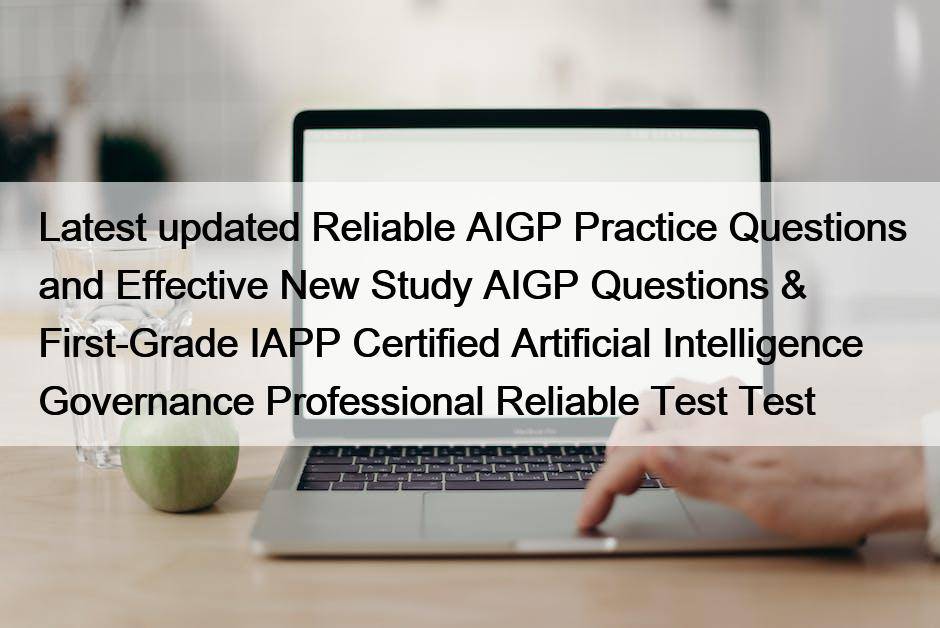Most Popular
 Exam 1Z0-1069-24 Collection Pdf & 1Z0-1069-24 Reliable Test Voucher
Exam 1Z0-1069-24 Collection Pdf & 1Z0-1069-24 Reliable Test Voucher
With a vast knowledge in the field, DumpStillValid is always ...
 Exam McAfee CCII Flashcards - Reliable CCII Exam Simulations
Exam McAfee CCII Flashcards - Reliable CCII Exam Simulations
We don't just want to make profitable deals, but also ...
 Latest C-S4CPB-2502 Exam Camp - C-S4CPB-2502 Free Exam Dumps
Latest C-S4CPB-2502 Exam Camp - C-S4CPB-2502 Free Exam Dumps
Real4dumps is subservient to your development. And our experts generalize ...



Latest updated Reliable AIGP Practice Questions and Effective New Study AIGP Questions & First-Grade IAPP Certified Artificial Intelligence Governance Professional Reliable Test Test

There are rare products which can rival with our products and enjoy the high recognition and trust by the clients like our products. Our products provide the AIGP study materials to clients and help they pass the test AIGP certification which is highly authorized and valuable. Our company is a famous company which bears the world-wide influences and our AIGP Study Materials are recognized as the most representative and advanced study materials among the same kinds of products. Whether the qualities and functions or the service of our product, are leading and we boost the most professional expert team domestically.
IAPP AIGP Exam Syllabus Topics:
| Topic | Details |
|---|---|
| Topic 1 |
|
| Topic 2 |
|
| Topic 3 |
|
>> Reliable AIGP Practice Questions <<
New Study AIGP Questions | AIGP Reliable Test Test
Once you have practiced and experienced the quality of our AIGP exam preparation, you will remember the serviceability and usefulness of them. For the excellent quality of our AIGP training questions explains why our AIGP practice materials helped over 98 percent of exam candidates get the certificate you dream of successfully. Believe me with our AIGP Guide quiz, you will be more confident to pass the exam in the shortest time with ease.
IAPP Certified Artificial Intelligence Governance Professional Sample Questions (Q82-Q87):
NEW QUESTION # 82
Which of the following steps occurs in the design phase of the Al life cycle?
- A. Data augmentation.
- B. Model explainability.
- C. Risk impact estimation.
- D. Performance evaluation.
Answer: C
Explanation:
Risk impact estimation occurs in the design phase of the AI life cycle. This step involves evaluating potential risks associated with the AI system and estimating their impacts to ensure that appropriate mitigation strategies are in place. It helps in identifying and addressing potential issues early in the design process, ensuring the development of a robust and reliable AI system. Reference: AIGP Body of Knowledge on AI Design and Risk Management.
NEW QUESTION # 83
Business A sells software that provides users with writing and grammar assistance. Business B is a cloud services provider that trains its own AI models.
* Business A has decided to add generative AI features to their software.
* Rather than create their own generative AI model, Business A has chosen to license a model from Business B:
* Business A will then integrate the model into their writing assistance software to provide generative AI capabilities.
* Business A is most concerned that its writing assistance software could recommend toxic or obscene text to its users.
Which of the following governance processes should Business A take to best protect its users against potentially inappropriate text?
- A. Business A should ask Business B for detailed documentation on the generative AI model's training data and whether it contained toxic or obscene sources.
- B. Business A should establish a user reporting feature that allows users to flag toxic or obscene text, and report any incidents to Business B.
- C. Business A should test that the AI model performs as expected and meets their minimum requirements for filtering toxic or obscene text.
- D. Business A should fine-tune the AI model on user-generated text that has been verified to be appropriate.
Answer: C
Explanation:
Business A is integrating a generative AI model licensed from a third party (Business B) and is primarily concerned with the risk of toxic or obscene outputs being delivered to users. In this scenario,testing and validationof the AI model for such content risks is the most direct and effective governance strategy.
According to theAI Governance in Practice Report 2024, organizations thatdeployAI must engage in performance monitoring protocolsand ensure systems perform adequately for theirintended purposes, including filtering harmful content:
"Operational governance... development of: #Performance monitoring protocols to ensure systems perform adequately for their intended purposes." (p. 12)
"Product governance... includes: #System impact assessments to identify and address risk prior to product development or deployment." (p. 11) Furthermore, under theEU AI Act, which sets the global standard many organizations aim to align with, there is a clear obligation to test and monitor systems for potential harmful behavior:
"The act imposes regulatory obligations... such as establishing appropriate accountability structures,assessing system impact, providing technical documentation,establishing risk management protocols and monitoring performance..." (p. 7) Option B directly reflects this best practice ofpre-deployment testing and validationto ensure that the model aligns with Business A's minimum content safety requirements.
Let's now evaluate the incorrect options:
* A. Fine-tuning on verified user-generated textmay improve model alignment but does not guarantee that the model will generalize correctly, especially if Business A lacks access to model internals (common in third-party licensing scenarios). Fine-tuning also introduces its own risks and may be contractually restricted.
* C. A user reporting featureisreactive, not preventive. While helpful for long-term monitoring and mitigation, it does not prevent the initial harm of toxic outputs, which isBusiness A's primary concern.
* D. Requesting documentation from Business Bis useful for transparency and risk management, but it does not replaceindependent verificationthat the model meets Business A's content safety standards.
Thus,testing the model's behavior for unacceptable outputs before deploymentis the most aligned approach with AI governance best practices and obligations.
NEW QUESTION # 84
CASE STUDY
A premier payroll services company that employs thousands of people globally, is embarking on a new hiring campaign and wants to implement policies and procedures to identify and retain the best talent. The new talent will help the company's product team expand its payroll offerings to companies in the healthcare and transportation sectors, including in Asia.
It has become time consuming and expensive for HR to review all resumes, and they are concerned that human reviewers might be susceptible to bias.
To address these concerns, the company is considering using a third-party Al tool to screen resumes and assist with hiring. They have been talking to several vendors about possibly obtaining a third-party Al-enabled hiring solution, as long as it would achieve its goals and comply with all applicable laws.
The organization has a large procurement team that is responsible for the contracting of technology solutions.
One of the procurement team's goals is to reduce costs, and it often prefers lower-cost solutions. Others within the company deploy technology solutions into the organization's operations in a responsible, cost-effective manner.
The organization is aware of the risks presented by Al hiring tools and wants to mitigate them. It also questions how best to organize and train its existing personnel to use the Al hiring tool responsibly. Their concerns are heightened by the fact that relevant laws vary across jurisdictions and continue to change.
All of the following are potential negative consequences created by using the AI tool to help make hiring decisions EXCEPT?
- A. Privacy violations
- B. Candidate quality
- C. Automation bias
- D. Disparate impacts
Answer: B
Explanation:
The correct answer is B. "Candidate quality" is not a negative consequence of using AI-rather, it is the intended benefit of using such tools (e.g., more efficient filtering of strong candidates).
From the AIGP ILT Guide:
"Automation bias, disparate impact, and privacy risks are well-documented concerns in AI-assisted hiring.
These risks may arise when AI models replicate biases present in training data or obscure the decision logic." AI Governance in Practice Report 2024 (Bias and Fairness Section) also warns:
"Improper AI use in hiring can lead to disparate impact, where neutral criteria disproportionately disadvantage protected groups." Candidate quality is a goal, not a risk, making B the correct answer for what is not a negative outcome.
NEW QUESTION # 85
Scenario:
A large multinational organization is rolling out a company-wide AI governance initiative. To build awareness and support adoption, they are evaluating different ways to train employees and stakeholders across departments, including legal, technical, marketing, and customer-facing roles.
Which of the following typical approaches is a large organization least likely to use to responsibly train stakeholders on AI terminology, strategy and governance?
- A. Providing information and education to customers and users to understand the capabilities and limitations of the AI tools with which they interact
- B. Providing training on AI ethics, based on the extent to which the organization seeks to promote a responsible AI culture
- C. Providing all technical employees education on AI development so they can retool and participate in the development of AI systems
- D. Providing role-specific training, based on whether the organization uses a centralized, federated or decentralized governance model
Answer: C
Explanation:
The correct answer is A. While educating technical staff is important, expecting all technical employees to be retooled as AI developers is unrealistic and not aligned with scalable governance practices.
From the AIGP ILT Guide:
"Training approaches should be role-specific and align with the individual's function and responsibilities...
Organizations typically do not expect every technical role to participate in model development." The AI Governance in Practice Report 2024 supports tailored approaches:
"Cross-functional training should be specific to the individual's role and exposure to AI risk... Role-based education supports scalability and comprehension." Thus, broad development training for all technical employees is the least practical and least likely approach.
NEW QUESTION # 86
You asked a generative Al tool to recommend new restaurants to explore in Boston, Massachusetts that have a specialty Italian dish made in a traditional fashion without spinach and wine. The generative Al tool recommended five restaurants for you to visit.
After looking up the restaurants, you discovered one restaurant did not exist and two others did not have the dish.
This information provided by the generative Al tool is an example of what is commonly called?
- A. Model collapse.
- B. Prompt injection.
- C. Overfitting.
- D. Hallucination.
Answer: D
Explanation:
In the context of AI, particularly generative models, "hallucination" refers to the generation of outputs that are not based on the training data and are factually incorrect or non-existent. The scenario described involves the generative AI tool providing incorrect and non-existent information about restaurants, which fits the definition of hallucination. Reference: AIGP BODY OF KNOWLEDGE and various AI literature discussing the limitations and challenges of generative AI models.
NEW QUESTION # 87
......
TrainingQuiz's providing training material is very close to the content of the formal examination. Through our short-term special training You can quickly grasp IT professional knowledge, and then have a good preparation for your exam. We promise that we will do our best to help you pass the IAPP Certification AIGP Exam.
New Study AIGP Questions: https://www.trainingquiz.com/AIGP-practice-quiz.html
- IAPP Certified Artificial Intelligence Governance Professional Updated Torrent - AIGP Training Vce - IAPP Certified Artificial Intelligence Governance Professional Pdf Exam 👌 Search for ▶ AIGP ◀ and easily obtain a free download on ⇛ www.passcollection.com ⇚ 🍌Examcollection AIGP Free Dumps
- IAPP Certified Artificial Intelligence Governance Professional Updated Torrent - AIGP Training Vce - IAPP Certified Artificial Intelligence Governance Professional Pdf Exam 🧍 Enter ▷ www.pdfvce.com ◁ and search for ▷ AIGP ◁ to download for free ❤AIGP Formal Test
- Examcollection AIGP Free Dumps ☮ Pdf AIGP Exam Dump 🍧 Valid AIGP Test Pattern 🙉 Search for ▷ AIGP ◁ and download exam materials for free through 【 www.pdfdumps.com 】 🕐AIGP Reliable Test Notes
- AIGP Valid Exam Pdf 🚥 Valid AIGP Guide Files 💔 AIGP Reliable Test Notes ✒ Download ✔ AIGP ️✔️ for free by simply entering “ www.pdfvce.com ” website 🧲Pdf AIGP Exam Dump
- IAPP AIGP Latest Dumps – Affordable Price and Free Updates 🤛 Open ⇛ www.vceengine.com ⇚ and search for ➥ AIGP 🡄 to download exam materials for free 🤢Examcollection AIGP Free Dumps
- 100% Pass IAPP - Latest Reliable AIGP Practice Questions 🏫 Search for ▛ AIGP ▟ and obtain a free download on ⇛ www.pdfvce.com ⇚ ⭕AIGP Vce Exam
- AIGP Valid Test Questions 🏣 AIGP Valid Test Questions 📳 AIGP Latest Exam Pass4sure 🔮 Search for ➤ AIGP ⮘ and download exam materials for free through ☀ www.pass4leader.com ️☀️ 🏁Valid AIGP Guide Files
- 100% Pass IAPP - Latest Reliable AIGP Practice Questions 🧖 Search for ➡ AIGP ️⬅️ and download it for free on ⏩ www.pdfvce.com ⏪ website 🛶Reliable AIGP Test Book
- New AIGP Test Topics 🕚 AIGP Valid Exam Pdf 🏗 Valid AIGP Test Pass4sure 🟨 ☀ www.real4dumps.com ️☀️ is best website to obtain 【 AIGP 】 for free download 🥶AIGP Study Materials Review
- 100% Pass IAPP - High Pass-Rate Reliable AIGP Practice Questions 🆓 Open website ✔ www.pdfvce.com ️✔️ and search for ✔ AIGP ️✔️ for free download 🕟Guaranteed AIGP Success
- Exam AIGP Sample 📖 AIGP Study Materials Review 🥞 New AIGP Test Topics 😷 Search for ▷ AIGP ◁ and download it for free on 「 www.examdiscuss.com 」 website 🦔AIGP Valid Exam Pdf
- AIGP Exam Questions
- ketab-ara.ir webanalyticsbd.com course.parasjaindev.com edgedigitalsolutionllc.com salesforcemakessense.com leobroo840.bloggip.com students.theh2academy.com temp9.henrypress.net digiksman.com course.codemsbians.com
Tags: Reliable AIGP Practice Questions, New Study AIGP Questions, AIGP Reliable Test Test, Exam AIGP Testking, Latest AIGP Exam Objectives